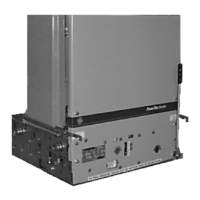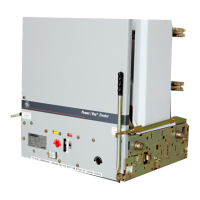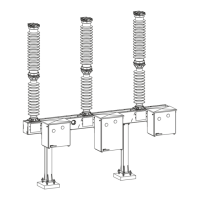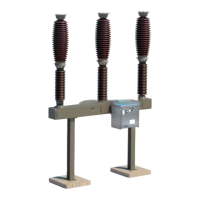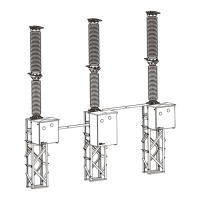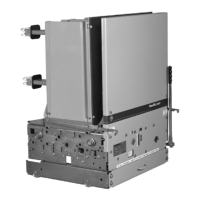
Do you have a question about the GE PowerVac GEK-86132G and is the answer not in the manual?
| Brand | GE |
|---|---|
| Model | PowerVac GEK-86132G |
| Category | Circuit breakers |
| Language | English |
Safety requirements for personnel and equipment, general industry practices.
Importance of maintenance programs, calibration of control devices, and user responsibilities.
Description of the PowerVac vacuum circuit breaker and its systems.
Summary of the breaker's function, mechanism type, and control.
Procedures for receiving equipment, inspection for damage, and filing claims.
Recommended methods for lifting and handling the breaker.
Precautions for proper storage of the breaker.
Warnings and precautions for working with the circuit breaker.
Description of the interlock systems provided with the breaker.
Ensures matching breaker and compartment ratings via an interference plate.
Prevents racking when the closing spring is charged.
Prevents closing operation by removing the trip latch.
Prevents racking of a closed breaker into or out of compartment.
Prevents gaged closing spring from entering metalclad unit.
General overview of the breaker's operation and mechanism.
Details the electrical and manual methods for charging the closing spring.
Describes the process of closing the circuit breaker.
Describes the process of opening the circuit breaker.
Explains the trip-free mechanism and operation.
Procedure for visually inspecting the breaker for damage.
Manual charging of the closing spring and indicator.
Procedure for installing and using the closing spring gag plate.
Method for manually performing a slow closing operation.
Procedure for removing the closing spring gag plate.
Checking for primary contact erosion and replacement criteria.
Measuring and adjusting wipe spring compression for ML-18.
Measuring wipe spring compression for ML-18H.
Procedure for measuring and setting the contact gap.
Checking and adjusting the coil plunger gap.
Detailed adjustment procedure for the close coil plunger gap.
Detailed adjustment procedure for the trip coil plunger gap.
Adjustment of LCS and SM/LS switches.
Adjustment of CL/MS switches for ML-18 and ML-18H models.
Adjustment procedure for the IL/MS switch.
Checking the electrical operation of the breaker.
Procedures for performing AC and DC high potential testing.
Hipot testing of the primary circuit phase-to-phase and phase-to-ground.
Hipot testing of the secondary circuit.
Measuring primary circuit resistance.
Testing the integrity of the vacuum interrupters.
Performing insulation resistance tests.
General design features for low maintenance.
Information on the vacuum interrupter's maintenance-free design.
Recommended format for reporting troubles.
How service conditions affect maintenance intervals.
Maintenance requirements after fault interruptions.
Checking and replacing based on contact erosion.
Inspecting transfer finger wear and replacement criteria.
Checking and tightening mechanism hardware.
Cleaning primary insulation parts.
Proper lubrication procedures for the mechanism.
Summary of recommended maintenance checks.
Overview of repair and replacement procedures.
Detailed steps for replacing interrupter assemblies.
Procedure for removing and replacing primary disconnect fingers.
Information on mechanism parts like pin retaining rings.
Procedures for removing and replacing control switches.
Tools and steps for replacing the trip coil.
Steps for replacing the closing coil.
Procedure for replacing auxiliary switches.
Steps for replacing the charge motor.
Procedure for replacing the 'Y' relay.
Guidelines for ordering replacement parts.
General information on mechanical adjustments.
Procedure for adjusting primary contact wipe.
Procedure for adjusting the primary contact gap.
Adjustment procedure for the trip coil plunger.
Adjustment procedure for the close coil plunger.
Adjustment of the close latch stop bolt.
Adjustment of the close spring discharge interlock.
Adjustment of the negative interlock.
